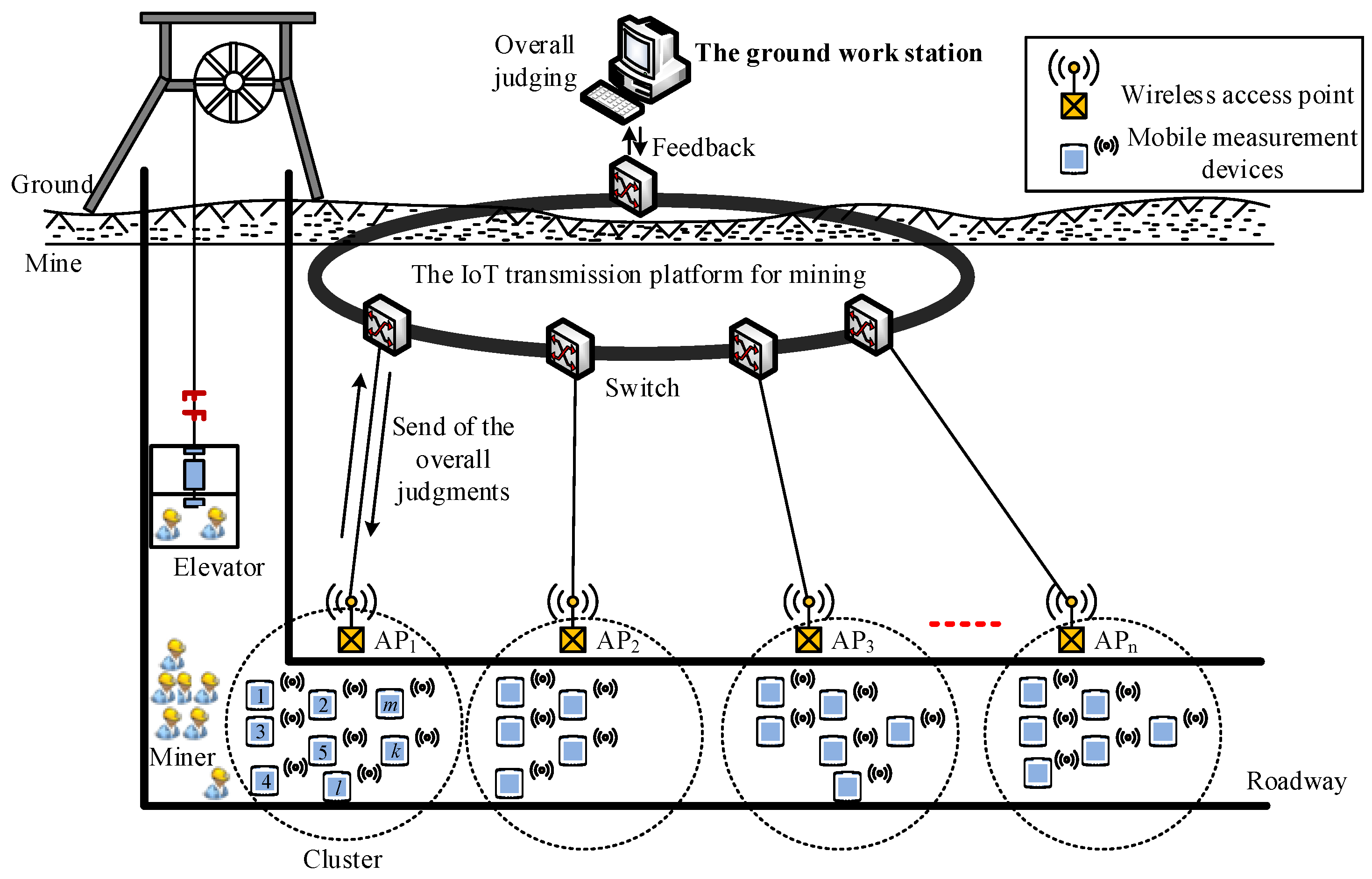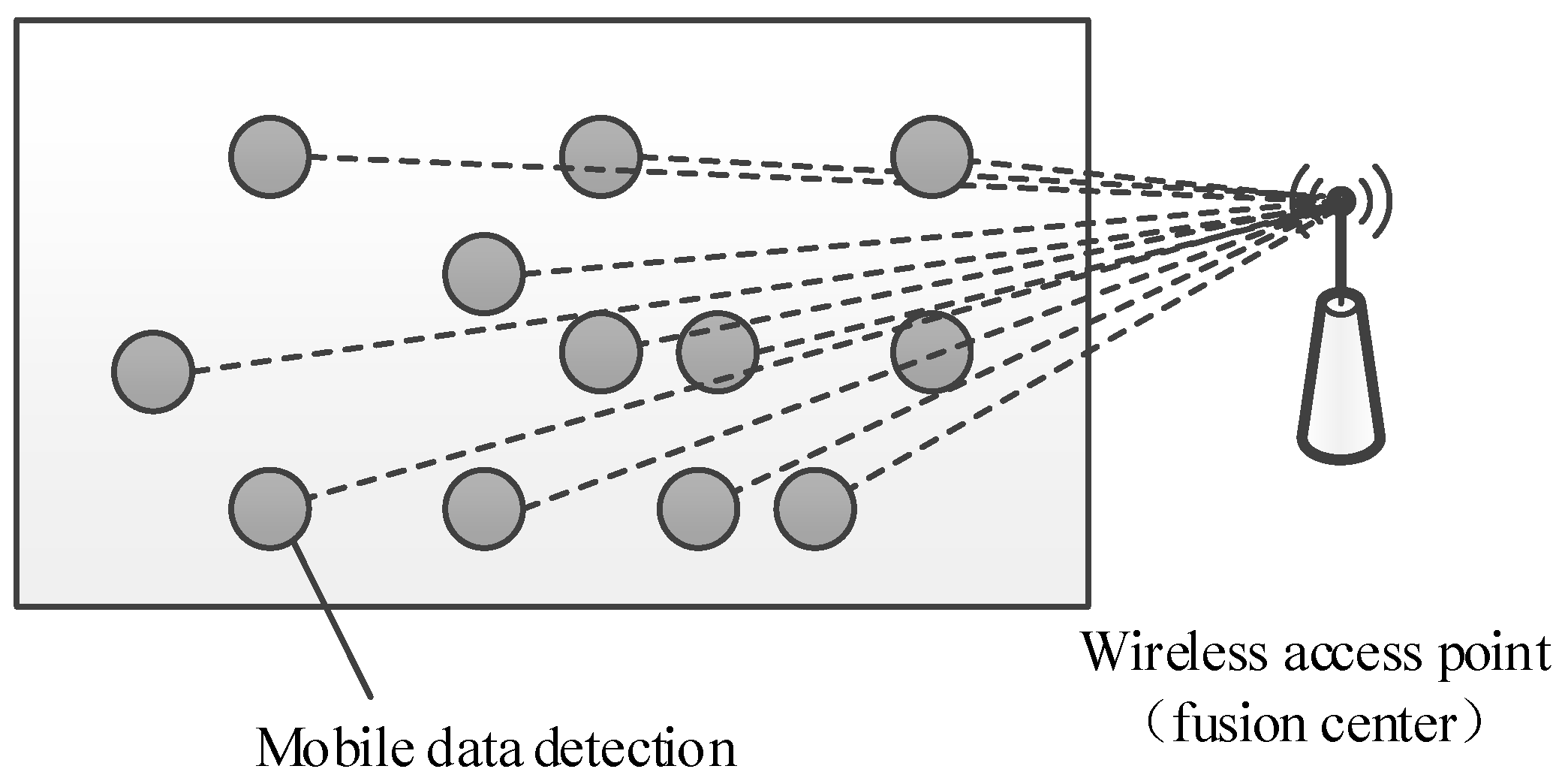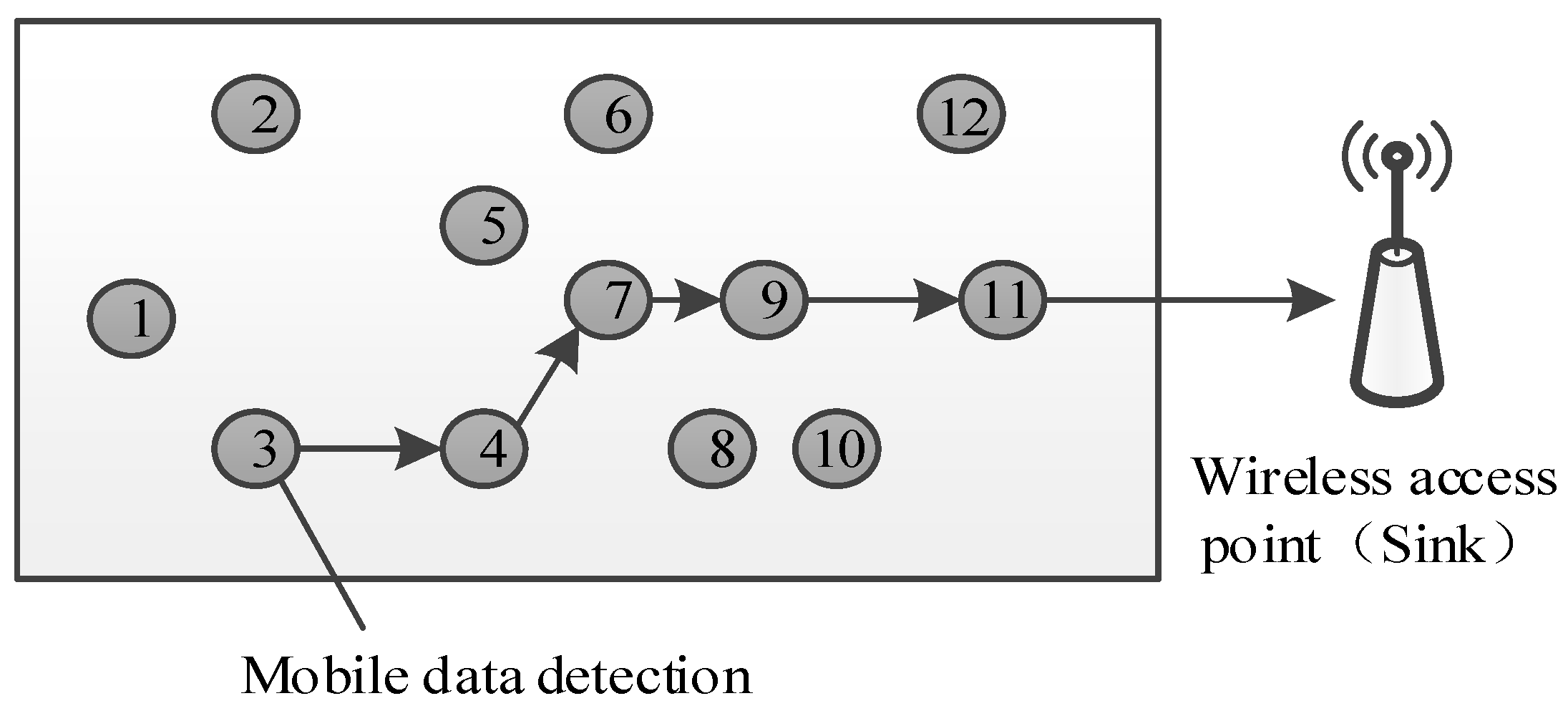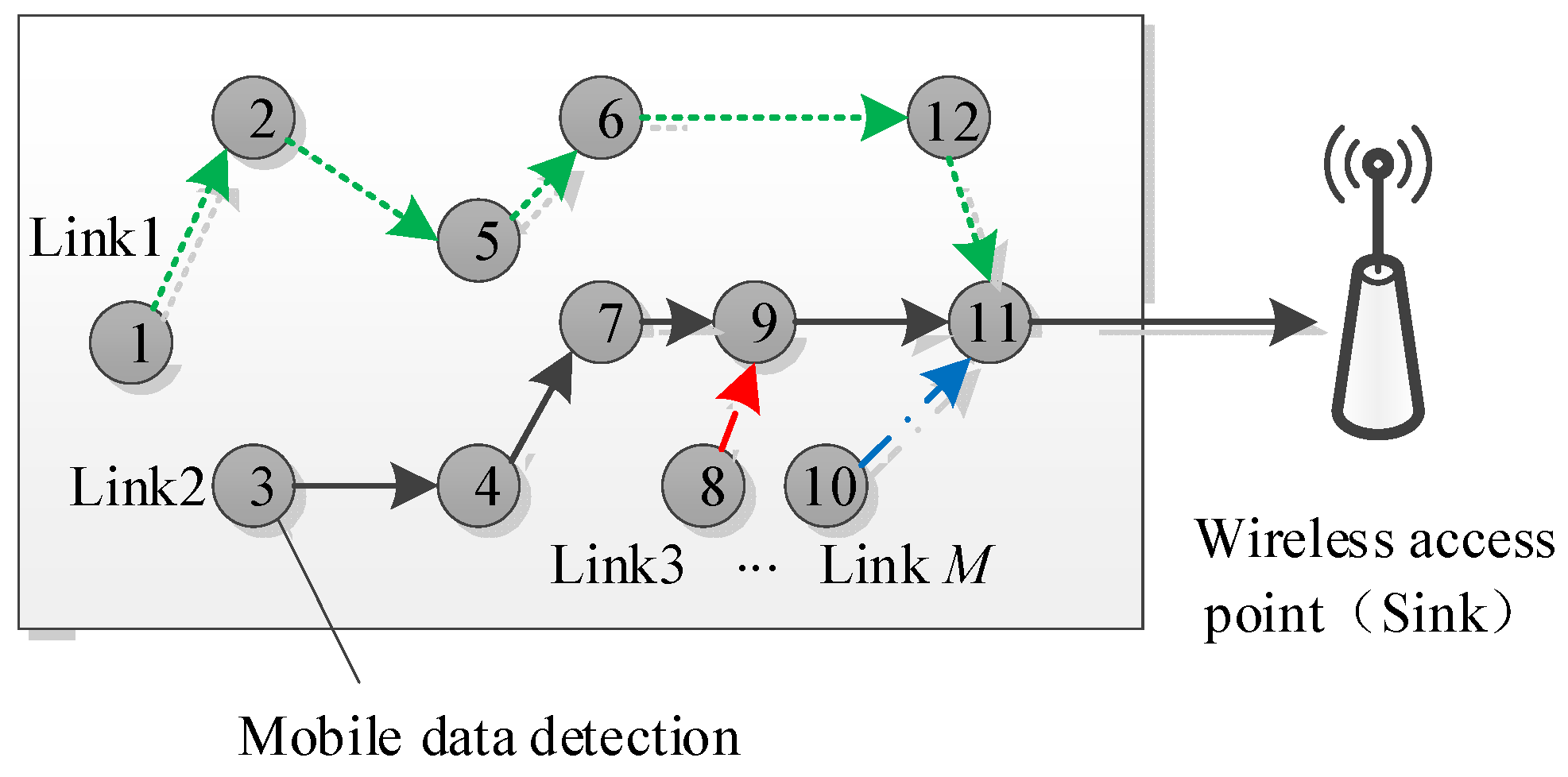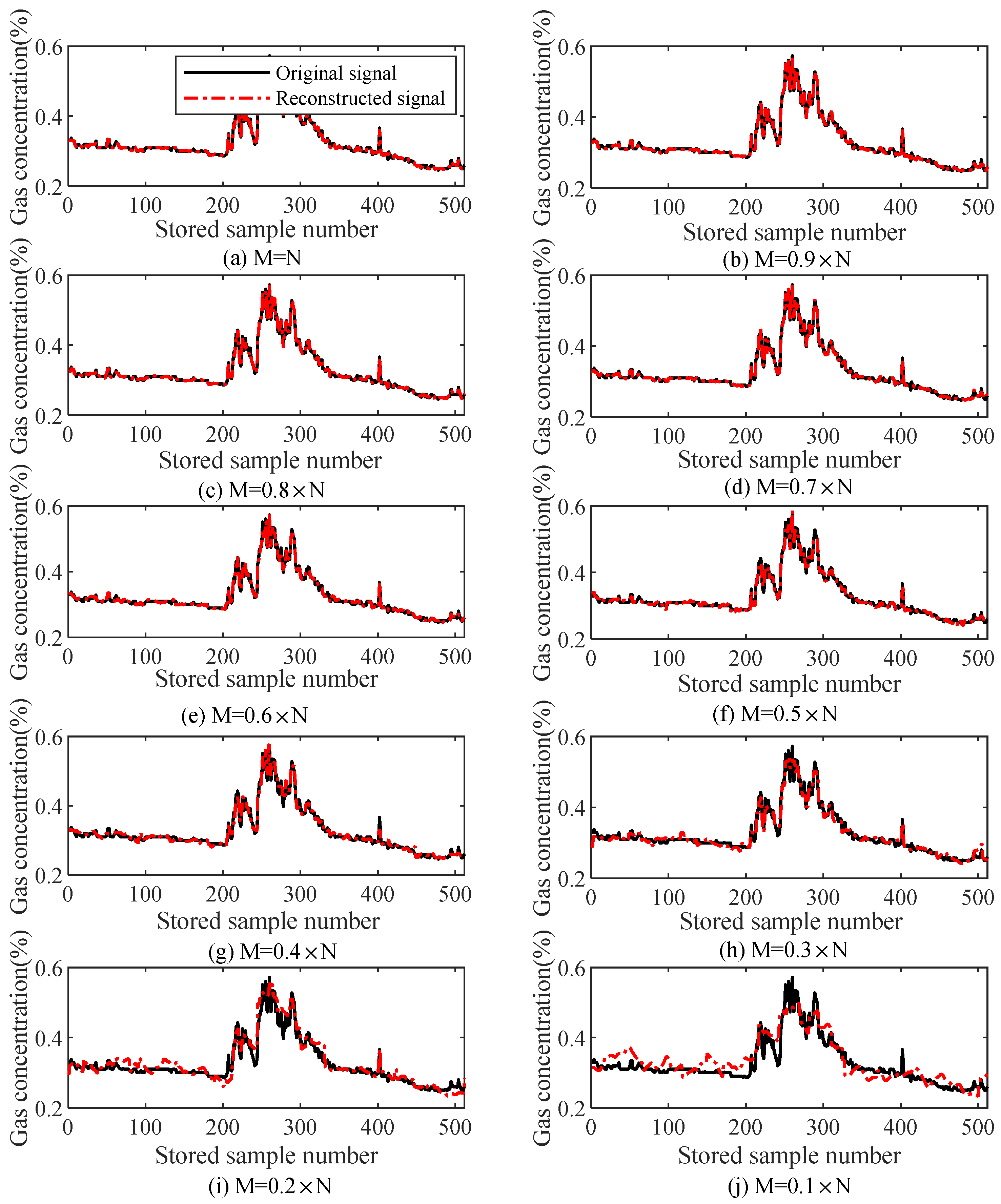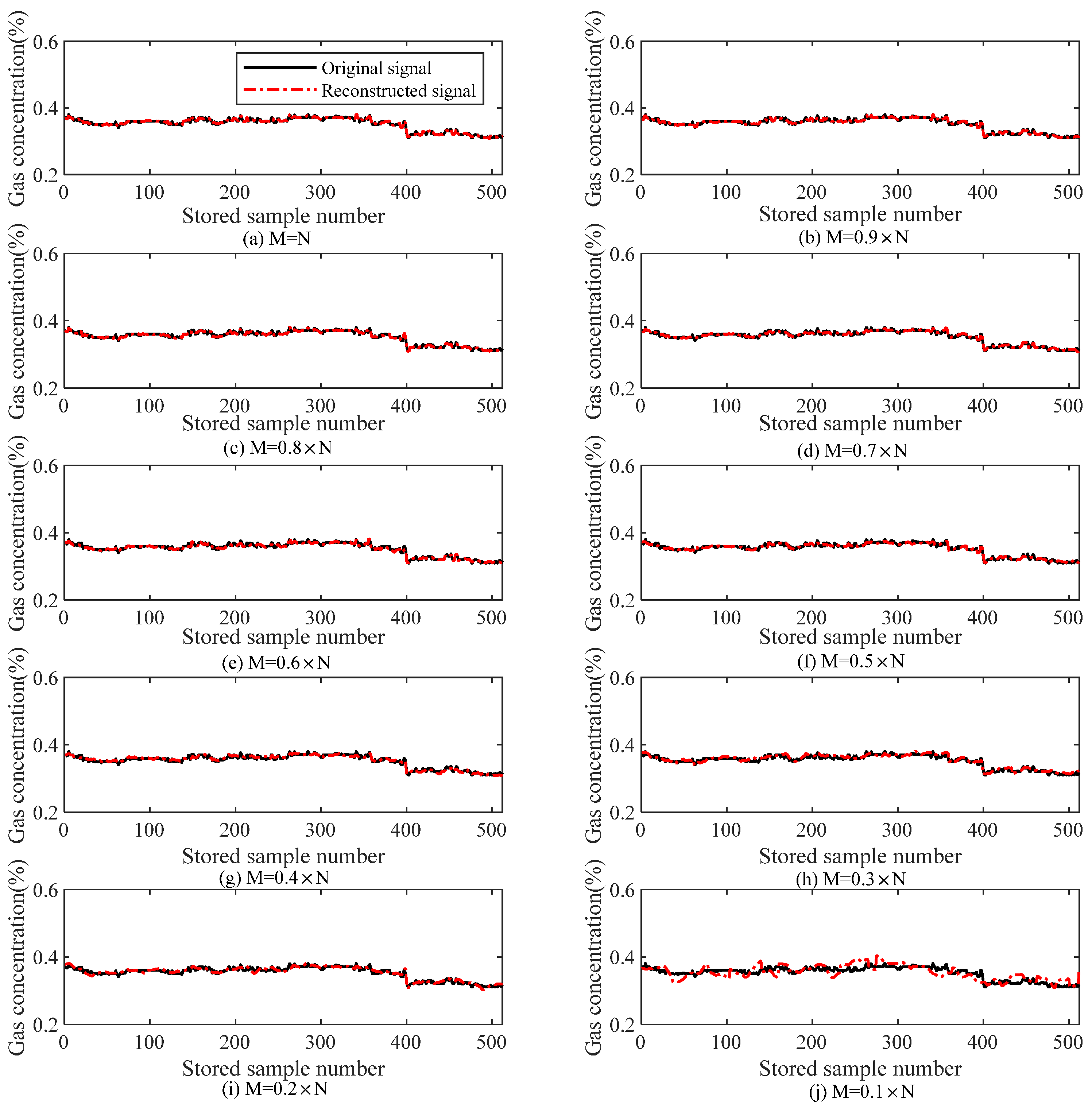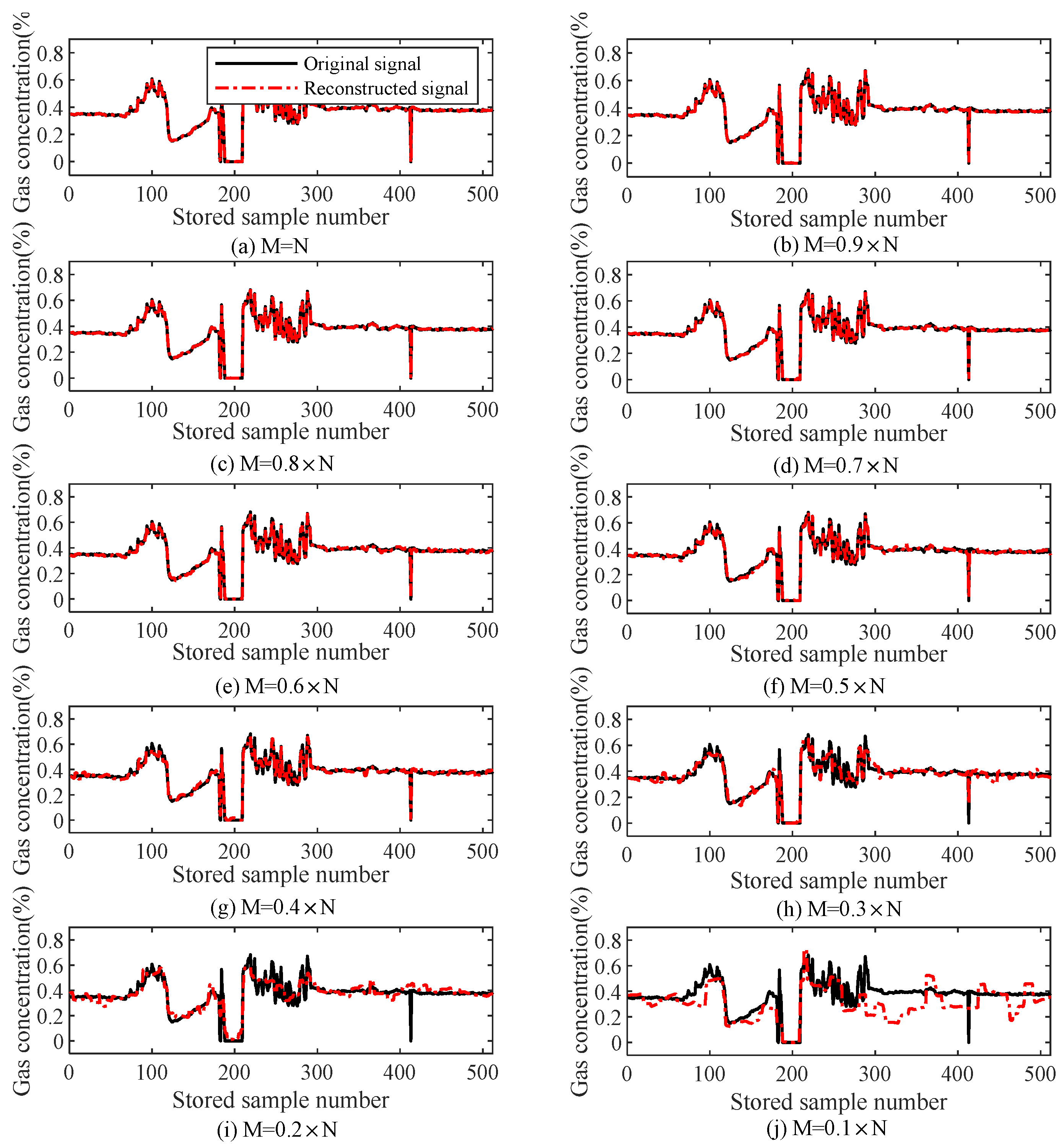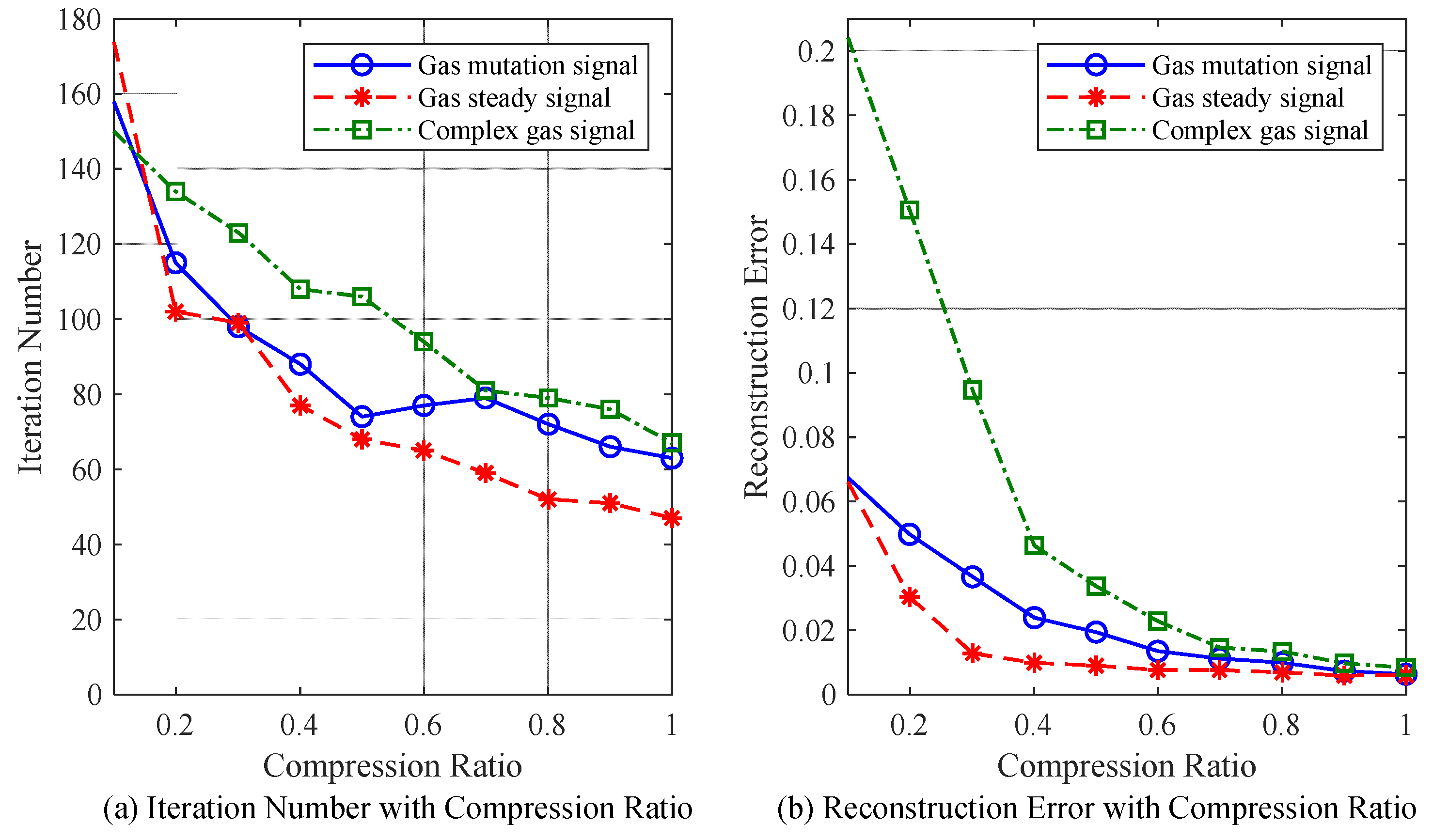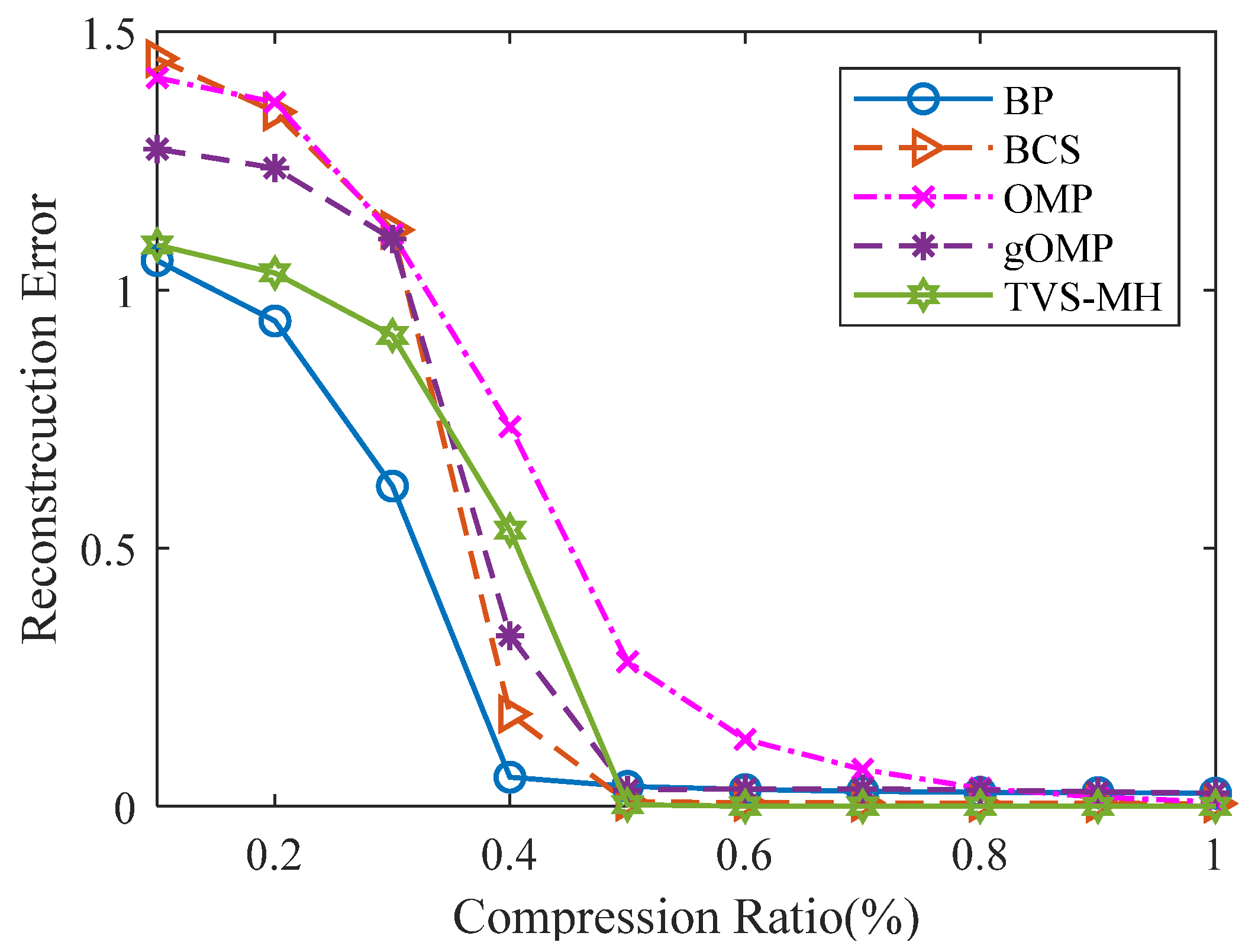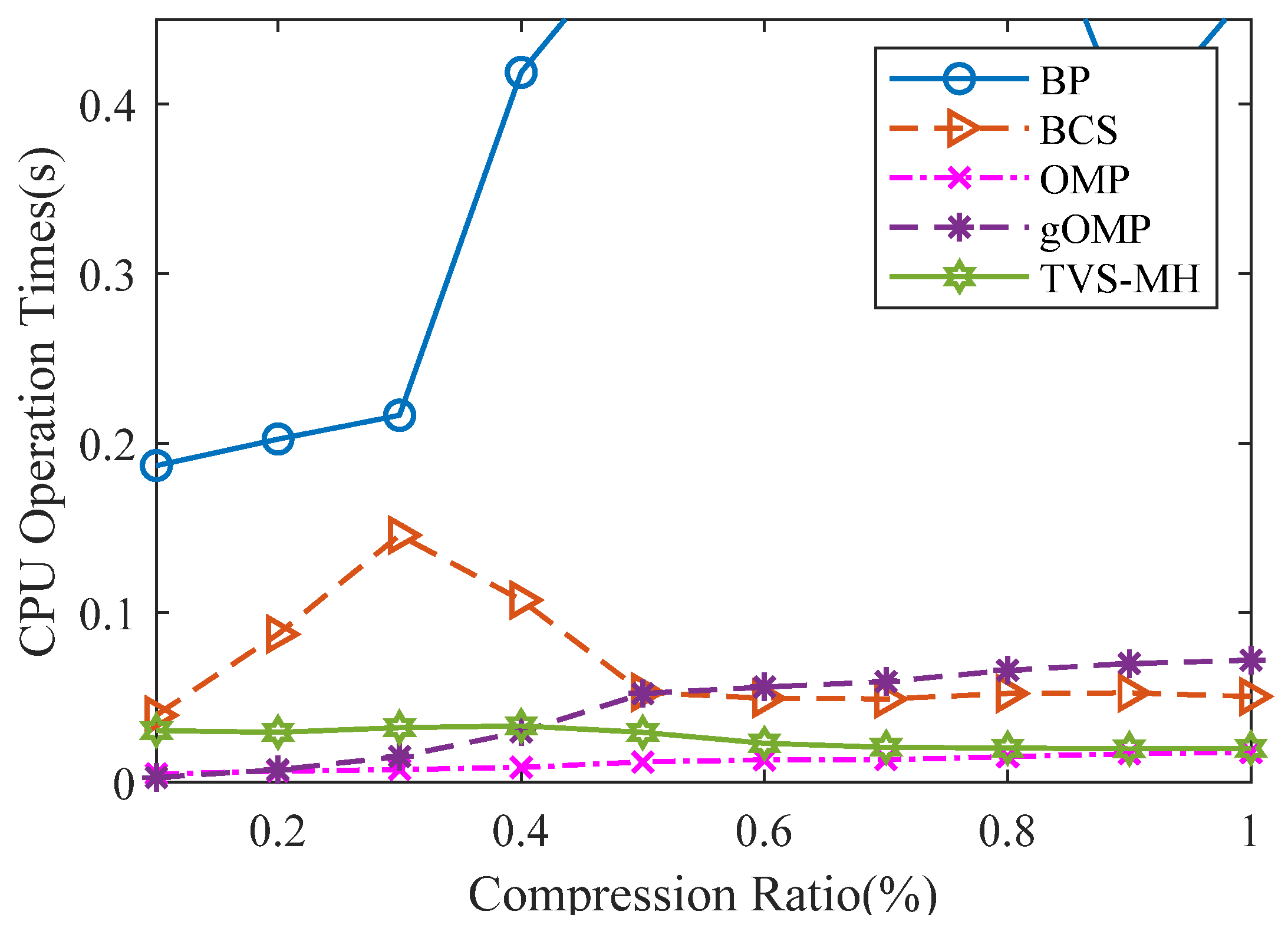1. Introduction
During the application of both a coal mine Internet of Things (IoT) mine and many mobile measurement devices (e.g., intelligent miner’s lamp), a large amount of moving measurement data is generated, and transferring these amounts of monitoring data efficiently is a challenge. The moving measurement data in mine IoT include mobile gas measurement data, mine equipment multi-channel measurement data, distributed mine monitoring data and mobile target location data. Different types of mobile data transmission and processing technologies have similarities. This paper presents a compressed sensing algorithm for coal mine moving measurement data based on a multi-hop network and total variation by taking gas data in the mobile measurement data as an example.
Underground gas is a kind of gas resource stored in coal and rocks; it gushes out during the mining of coal and causes a gas outburst under certain conditions. Gas explosion poses grave threats to coal’s safe production. The coal mine safety monitoring system needs to monitor the environmental parameters such as gas concentrations, wind speed, dust concentrations and so on. The traditional gas sensors are basically fixed-point detection sensors, so the amount of monitoring data is not great. With the development of mine IoT, a great number of intelligent miner’s lamps are put into use. For example, in a large mine, there are approximately a thousand people who work underground every day. The miner’s lamp and cap are necessary for workers to work underground and gas sensors are in the cap and move with the miners. It can be regarded as a mobile measurement system for underground gas. Compared with the fixed gas sensors, the application of the mobile gas sensors not only expands the monitoring range, but also can obtain the variation curve of gas with time in different positions along the coal mine roadway. In a smart cities environment, a fog-supported smart city network (FOCAN) architecture for management of everything is proposed [
1], which can provide services with low energy usage. Habib et al. studied the barrier coverage in wireless sensor networks for intrusion detection and border surveillance [
2]. The network in an underground coal mine is an industrial Ethernet, which is a relatively closed network, and the underground access users are authorized users. Miners work underground for no more than 10 h, and every miner’s lamp will be fully recharged before he goes down the mine, so energy conservation is not the main problem. At the same time, the coal mine roadway is a long linear structure, which makes the network structure different from that in ground application.
As intelligent miner’s lamps became widespread in mines, the amount of moving measurement data increased dramatically. How to achieve high-efficiency acquisition and transmission of gas data flow appears to be an urgent problem that needs to be solved for underground distributed mobile gas detection systems.
For scalable distributed in-network computation, data compression proves to be an effective solution for achieving high-efficiency transmission and storage of gas monitoring data. The SensorScope project undertaken by the Lausanne Federal Institute, Switzerland, used a wireless sensor network for monitoring environmental information [
3]. Yin et al. developed a gas data compression method for gas time series based on prediction and run-length coding [
4]. To overcome the inefficiency of intelligent algorithms induced by the high-dimensional characteristics of coal gas data, Zhao et al. proposed a graph-based parameter-free dimensionality reduction algorithm and a locality-preserving semi-supervised dimensionality reduction algorithm [
5]. A sub-band energy adaptive data compression (SEADC) method in wireless network was proposed by Huang et al. [
6]. According to the data-streaming characteristics in the sensor network, Xie et al. proposed a mixing entropy data compression based on interval wavelet transformation to achieve the compression on streaming data in the sensor network [
7]. Ziv et al. presented a universal algorithm for sequential data compression through which performance is investigated with respect to a non-probabilistic model of constrained sources [
8]. How to make use of the correlation between mobile gas data and realize the simultaneous recovery of multiple measurement nodes with a small number of measurement data still needs to be studied.
Compressed sensing takes full advantage of the signal’s sparsity and can perform non-adaptive measurement encoding on the signal at a far lower sampling rate than the Nyquist sampling rate. Due to the novelty in its theoretical framework, compressed sensing now has provided some new ideas for many practical signal processing problems [
9]. Sparse recovery algorithms can be classified into three main categories: Convex and Relaxation, Greedy, and Bayesian [
10]. In the application of data monitoring based on Wireless Sensor Network, Xue put forward multiple access and data reconstruction in wireless sensor networks based on compressed sensing [
11]. Uthayakumar et al. presented a data compression algorithm to maximize network lifetime in wireless sensor networks [
12]. Lossy transmission is a common problem for monitoring systems based on wireless sensors; Zou et al. presented a data loss recovery technique based on compressed sensing to enhance communication reliability [
13].
In view of the long linear structure of coal mine roadways and the time sparsity of gas sensors, a compression and reconstruction algorithm for a coal mine network transmission structure is studied in this paper. The algorithm takes advantage of the time correlation of the mobile gas monitoring data in multi-hop networks and realizes the sparsity of monitoring data by introducing total variation. By studying the relationship between data transmission and compressed sensing in multi-hop networks, a Total Variation Sparsity based on Multi-Hop (TVS-MH) algorithm is proposed, and the effectiveness of the algorithm is verified. The rest of this paper is organized as follows.
Section 2 introduces the model of the mine IoT monitoring system, which is a mixed network of wired and wireless networks.
Section 3 introduces the basic theory of compressed sensing, and a compressive acquisition model based on compressed sensing for gas data flow is presented in
Section 4. Then, in
Section 5, a high-efficiency gas data compression and reconstruction method TVS-MH is proposed.
Section 6 presents gas data reconstructed based on TVS-MH. A series of tests show that the moving measurement data flow from an underground distributed mobile network can be acquired and transmitted efficiently by using the proposed method. Finally, conclusions are drawn in
Section 7.
3. Theoretical Framework of Compressed Sensing
3.1. Theoretical Framework
Traditional signal acquisition and processing includes four steps: sampling, compression, transmission, and decompression. The sampling process should satisfy Shannon’s sampling theorem. Compressed sensing performs signal sampling and compressive encoding in a step. As illustrated in
Figure 2, compressed sensing takes full advantage of the signal’s sparsity and conducts non-adaptive measurement and encoding on the signal at a sampling rate far lower than the Nyquist sampling rate.
Compressed sensing includes the following three steps [
9]:
- (1)
The original signal x, with a length of N, is sparse or sparse under the base of , and the sparse signal is denoted as S;
- (2)
The observed value y was acquired based on the observation matrix ;
- (3)
Based on the given , and y, an appropriate algorithm was selected for the recovery of x.
Accordingly, compressed sensing includes the sparse representation of a signal, the design of the measurement matrix, and the reconstruction algorithm. The sparse representation of a signal is the prerequisite; the measurement matrix is the means of the structured representation of the signal; and the reconstruction algorithm serves as the guarantee of signal reconstruction.
3.2. Sparse Representation of the Signal
For a signal, if only a few of the elements are nonzero, it can be considered sparse. Generally, natural signals in the time domain are non-sparse but can be sparse in some transform domains. These signals require sparse representation. Signal’s sparse representation is a concise representation; specifically, when the signal is projected into the orthogonal transform basis, most of the transformation coefficients indicate small absolute values and the acquired transformation vectors are sparse or approximately sparse. This is also the priori condition of compressed sensing, i.e., the signal must be represented in a sparse manner under certain transformations.
A one-dimensional discrete time signal with a length of
N can be expressed as the following linear combination of a set of orthogonal bases:
where
(
denotes the
i-th column vector). Apparently,
s is an equivalent representation of
x. If s only includes few great coefficients, then x is compressible; if
s only has
K nonzero elements, then s can be regarded as a
K-sparse representation of the signal
x [
14].
In general applications, the transformation basis can be set as flexible according to signal characteristics. Some commonly used transformation bases include the discrete cosine transform (DCT) basis, the fast Fourier transform (FFT) basis, the discrete wavelet transform basis [
15], the Curvelets basis [
16], and the Gabor basis [
17]. For signals that cannot be represented using orthogonal bases, sparse representation can be conducted by means of a redundant dictionary [
18,
19].
3.3. Measurement Matrix
Given a K-sparse signal x with a length of N, and a measurement matrix , we then calculated the measured value. If x is sparse, then the measured value could be calculated by , ; if x is non-sparse, then we first performed sparse representation and then calculated the measured value, . Each row of can be regarded as a sensor. Part of the information can be picked up by multiplying the signal by .
To achieve the reconstruction of signal, Candès and Tao proposed and proved that the sensing matrix
should satisfy the restricted isometry property [
20]. For any
K-sparse signal
v and a constant
, if
is satisfied, then the matrix satisfies the restricted isometry property. Candès et al. proved that if
is a Gaussian random matrix, then the sensing matrix
can most likely satisfy the restricted isometry property [
21]. Therefore, we can select a Gaussian measurement matrix, with a size of
, to construct
, in which each value satisfies the independent normal distribution of
. Some other measurement matrices that can make the sensing matrix satisfy the restricted isometry property include the consistent spherical/ball matrix, the two-value/binary random matrix, the local Fourier matrix, the local Hadamard matrix and the Toeplitz matrix [
22].
3.4. Reconstruction Algorithm
A signal reconstruction algorithm is the core of compressed sensing theory and refers to the reconstruction of the sparse signal
x with a length of
N from the measurement vector
y with a length of M. Since
and the dimension of
y is far smaller than that of
x, the equation has infinitely many solutions and the signal cannot be reconstructed. However, if the original signal is
K-sparse and the measurement matrix satisfies certain conditions, the signal
x can be accurately reconstructed from the measured value
y through the solution of the
norm. The reconstruction was proved theoretically and can be written as follows:
where
denotes the vector’s
norm, which is the number nonzero elements in the vector
x.
4. The Compressive Acquisition Model for Gas Data Flow
Compressive-sensing-based signal compression, acquisition and recovery has the following characteristics.
- (1)
Encoding end is simple: only a measurement matrix that follows random distribution and satisfies incoherence is required and codes are non-adaptive.
- (2)
Encoding and decoding are unequal to each other: at the encoding end, the computation is simple, indicating less energy consumption and uniqueness; at the decoding end, the computation is quite complex, and many reconstruction algorithms can be selected.
- (3)
Compressed sensing is characterized by robustness and noise immunity. Since the measurement matrix has allotted high-dimensional signal information to each measured value, each measurement coefficient indicates the same importance or unimportance and the errors caused by the loss of several measurement coefficients are the same.
Therefore, compressed sensing is particularly applicable to signal processing systems that require low-energy-consumption sensor encoding but have high computing capability at the decoding end. The gas data detected by a mobile gas detection instrument were transmitted to wireless access points via a wireless network; when multiple mobile gas detection instruments moved underground, the mobile gas detection instruments near a wireless access point constituted a wireless sensing network. The mobile gas detection instruments were poor in data processing, but the principal computer exhibited extremely strong signal processing capability; therefore, the mobile gas detection instruments constituted a system that is exactly suitable for the compressed sensing theory.
4.1. Two Different Networks for the Transmission of Gas Data Flow
Data between two wireless access points can be transmitted through two different types of networks, namely the single-hop network and the multi-hop network. These two networks have different data transmission modes. This paper assumes that different routing protocols can be completed through selected routing protocols.
4.1.1. The Single-Hop Mode
As illustrated in
Figure 3, the current study assumed that all mobile gas detection instruments were within the communication range of wireless access points, periodically measured the environmental gas data and directly sent the data to wireless access points (fusion centers).
Assume that
N denotes the number of mobile gas detection instruments and
denotes the gas data measured by the
j-th sensor. According to the requirements of compressed sensing theory, the measured gas data by each mobile gas detection instrument at
M time intervals were multiplied by
M random coefficients
, and the products were then transmitted to wireless access points. The random coefficients were generated by setting the ID of the mobile gas detection instrument as the seed of the pseudo-random sequence generator. At the
i-th time interval,
N mobile gas detection instruments simultaneously transmitted
to wireless access points; therefore, the signal received by the wireless access point at the i-th time interval can be written as [
23,
24]:
At each time interval, the signal received by the wireless access point is the sum of all the N measurements of mobile gas instruments multiply the N random coefficients , so the wireless access point is also called fusion center.
At the end of
M time intervals, the signal vector received by wireless access points can be written as:
. In a matrix form, y can also be rewritten as follows:
where
denotes an
M ×
N matrix.
Although the transmitted gas vector
is not sparse, gas vectors can be regarded to be sparse in some transform domains due to the spatial correlation of physical phenomena. By assuming the gas vector
has a decomposition coefficient
s under certain orthogonal bases, and
s is sparse, the following expression can be acquired:
It can thus be transformed into a standard compressed sensing problem.
4.1.2. The Multi-Hop Mode
As illustrated in
Figure 4, in addition to the single-hop mode, data can be transmitted through a multi-hop mode when multiple mobile gas detection instruments move between two wireless access points. Data were aggregated as follows.
Data were acquired though
M time-independent multi-hop communication links with different initial nodes. Each multi-hop network randomly selected an initial node. At each node, the measured gas value was multiplied by the generated random coefficient; then, the product was transmitted to the next node according to the preset routing algorithm. At the next node, the received signal was added to the local product, and the sum was transmitted to the next node. By analogy, the
i-th multi-hop signal received by the wireless access point can be written as [
25]:
where
denotes the node index set of the
i-th multi-hop communication link,
denotes the random coefficient at the
j-th node, and
denotes the gas data measured at the
j-th node. Similarly, based on the spatial correlation of the measured gas data, the signal vector received by the wireless access point
can be written as follows:
where
denotes an
M ×
N matrix (when
, the element at the
i-th row and the
j-th column equaled
; otherwise, equaled 0). Accordingly, it can be regarded as a standard compressed sensing problem.
4.2. Compressive Acquisition Model of Gas Data Flow
In the current study, a mobile gas detection instrument was mounted on a miner’s lamp, in which the GS1011 low-power consumption Wi-Fi chip was the hardware core. Since the miner’s lamp took multiple functions (sensing, lighting, and energy communication), low energy consumption of the mobile gas detection instrument should be an important constraint. Considering the lamp’s limited energy, the multi-hop communication mode was preferable when several mobile gas detection instruments moved between two wireless access points.
Accordingly, the signals on
M time-independent multi-hop communication links with different initial nodes should be collected. As illustrated in
Figure 5, by assuming that
denotes the
i-th multi-hop signal received by a wireless access point (
), in which
denotes the random coefficient generated at the
j-th node in the
i-th multi-hop communication link and
denotes the gas data measured at the
j-th node, the receiving vector of
M multi-hop communication links was denoted as
, i.e.,
.
Selection of measurement matrix is a critical step in the practical application of compressive sensing theory. The related theory has proved that, when
, all
K-sparse vectors can be stably recovered from some random measurement matrices such as Gaussian matrix, Bernoulli matrix or Fourier random matrix. However, if a random matrix was generated in each measurement and recorded for finally reconstruction, the system cost would be increased in practical applications, which is not beneficial for physical implementation. Therefore, some mathematicians proposed to use deterministic measurement matrix and structured measurement matrix to replace the random matrix. Some theoretical and experimental results also proved that structured measurement matrix is an effective choice. In the proposed compressive acquisition model, the communication links are generated according to the adopted multi-hop route which is determined, and the coefficient generated at the
j-th node in the
i-th multi-hop communication link is random, so the
is pseudorandom. It satisfies the RIP properties [
26].
5. Gas Data Reconstructed Based on TVS-MH
Reconstruction of gas data is the core of compressed sensing of gas data flow. It can be theoretically proved that, if the gas data are
K-sparse and the measurement matrix satisfies certain conditions, the signal
x can be accurately reconstructed from the measured value of
y by solving the
-norm problem:
However, Donoho pointed out that the minimum
-norm problem is also an NP-hard problem and all possible arrangements of non-zero values in (
) should be exhausted. Therefore, scholars proposed a series of algorithms for near-optimal solutions. Gas signals are generally slowly varying and only exhibit occasional rapid variations at mutation points, and the mobile measurement points measure the gas data at the same time and in the same space; this means that
in most cases. Therefore, the total variation of
can be defined as follows:
where
is a dual-diagonal matrix, and
denotes the element in the
i-th row of
D.
D can be written as follows:
The total variation function assigned larger values to rapidly-varying
x. Accordingly, the reconstruction problem can be rewritten as follows:
To acquire the minimum, the following augmented Lagrangian function was introduced:
Equation (13) can be solved using an iterative algorithm, and the unknown parameters
and
can be selected according to the following Equations (14) and (15):
where the superscript
k denotes the
k-th iterated value.
In contrast to the standard Lagrangian function, the augmented Lagrangian function included a quadratic penalty function.
Algorithm 1 presents the detailed procedures of data reconstruction using the TVS-MH algorithm.
| Algorithm 1. The TVS-MH Algorithm. |
| 1. Input:, , , . |
| 2. Step1: Select M time-independent multi-hop communication links with different initial nodes in a cluster |
| 3. Step2: Assign the i-th multi-hop signal received by the wireless access point as (). |
| 4. Step3: Calculate all of the M multi-hop communication links to form a gas data compressed sensing collection model based on the multi-hop network |
| 5. Step4: Calculate the total variation of : |
| 6. . |
| 7. Step5: Solve the reconstruction problem that can be rewritten as follows: |
| 8. . |
7. Conclusions
With the development of coal mine IoT, a great number of intelligent miner’s lamps are put into use which has led to the multiplication of monitoring data. Data compression appears as an effective solution to high-efficiency transmission and storage.
In view of the long linear structure of the coal mine roadway and the time sparsity of gas sensors, the paper studies the relationship between data transmission and compressed sensing in multi-hop networks and a Total Variation Sparsity based on Multi-Hop (TVS-MH) algorithm is proposed, which takes advantage of the time correlation of the mobile gas monitoring data in multi-hop networks and realizes the sparsity of monitoring data by introducing total variation.
The current study analyzed the sparseness characteristics of gas data, investigated the network model suitable for the transmission of gas data flow and used a pseudorandom measurement matrix to replace a random measurement matrix for performance improvement. Finally, through the intrusion of total variation of gas data, gas data were accurately and efficiently reconstructed using the TVS-MH algorithm. The present results indicate that high-efficiency acquisition and transmission of the measured data by mobile sensors in a distributed measurement network are possible.
